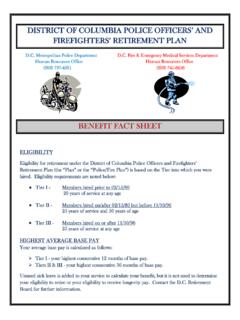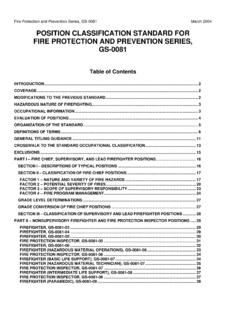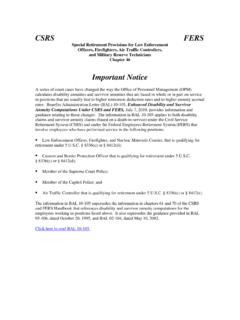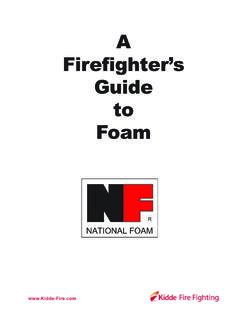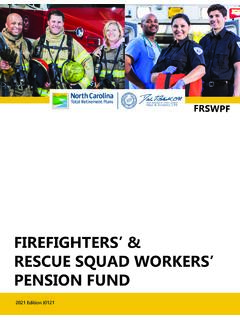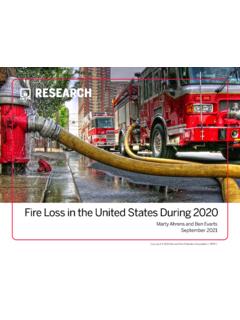Transcription of GUIDELINES FOR FIREFIGHTER PHYSICAL EXAMINATIONS
1 1 GUIDELINES FOR FIREFIGHTER PHYSICAL EXAMINATIONSH eart attack is the most common cause of on-duty FIREFIGHTER fatalities. Yet, existing regulations do not require firefighters topass periodic medical EXAMINATIONS . Everyyear, firefighters needlessly die on duty because their medical conditio ns are not identifiedor properly treated. This is especially a problem withvolunteerfirefighterswho often tendto be older than their counterparts in career departments. Recommendations: Pre-placement PHYSICAL EXAMINATIONS :This examination should be similar to that conducted for police candidates.
2 Periodic Reexaminations: Incumbent firefighters should be required tocompletea reexamination on an annual basisand this examination should include calculation of each FIREFIGHTER s heart attack risk. Background:In 2007, the National Institute for Occupational Safety and Health (NIOSH) issued an alert that sudden cardiac death represents the most common cause of on-duty FIREFIGHTER fatalities. The report concluded that 39% of fatalities involving career firefighters and 50% of fatalities involving volunteers are due to sudden cardiac higher incidence among volunteers is due to the fact that volunteers tend to be older.
3 43% ofthe heart attacks involved firefighters over 55and one-sixth involved firefighters overage 65. In the United States, heart attacks are the number one cause of death, striking at least 600,000 Americans each year. In half of the cases, the first symptom is death. Ina recent New England JournalofMedicinestudy, Dr. Stefanos Kates of Harvard Universityconcluded that, firefighters do not have a higher risk of heart disease compared to the general population, but the sudden exertion of their work can trigger aheart attack in the same way shoveling snow can lead to a heart attack in someone else.
4 firefighters may begin their careers in better shape than others, but as they grow older they may acquire risk factors, such as high blood pressure and cholesterol aswellas weight gain. Despite growing awareness of the problem, the incidence of FIREFIGHTER deaths from heart attacks has not changed in the last key to turning this around is to require every FIREFIGHTER over 35 to have an annual cardiac risk assessment. Raymond , a diagnostic cardiologist who specializes in FIREFIGHTER issues, wrote, Any individual with risk factors above 10% over the next ten years should be made aware of the risk factors that could be improved to lower risksuch as smoking or high blood pressure.
5 All high-risk individuals should be asked to see their own doctors. The fire service should2not exclude these members from serving, but ask that their own doctors ensure their safety and review their situation. The department s medical examiner should not accept any clearance for a member with chest discomfort and a high risk score that does not include a stress test. Daniel Samo, , an advisor to the National Fire Protection Association (NFPOA) recommends that firefighters who have a cardiac risk score above 10% should be required to pass a stress test at 12 METS to establish that Ischemia (signs of the lack of oxygen to the heart) does not occur at the work level common to firefighting.
6 Because of the nature oftheir work, fire fighters should also be encouraged to monitor and control their blood pressure, cholesteroland weight, and stop smoking to ensure that their risk of heart attack is within reasonable limits. Because of the high stress associated withall aspects of firefighting, it may not be sufficient to limit high risk individuals from interior firefighting. Experience suggests that exempt fire fighters can also experience heart attacks while performing light duties such as directing traffic oroperating a is crit ical that municipalities address this problem because volunteer fire departments provide an important service.
7 On average, volunteer departments save the taxpayers $147 per resident as compared to career departmentsand the savings for each volunteer averages $26,700 Current Examination Requirements:Atpresent, state regulations only require PHYSICAL EXAMINATIONS for firefighters involved in special assignments such as HazMat teams. However, most towns require candidates to pass a medical before joining thefire departmentand a PHYSICAL is also required to become a member of the NJ State Firemen s Association. Thisexamination does not require that the candidate meet explicit PHYSICAL standards, although it does require certification from the examiner that the applicantis free from disease and has no PHYSICAL defects that would hinder the abilityto performthe duties of a FIREFIGHTER .
8 This examination can be performed by any licensed NJ Public Employee Occupational Safety and Health Administration (PEOSHA) requires that firefighters who are assigned to interior structural firefighting be qualified to use a respirator. Under this regulation, firefighters complete aquestionnairethat is reviewed by a physician or other licensed health care professional. If in the judgment of the reviewer the questionnaire responses are satisfactory, no direct PHYSICAL examination is required. The examiner must specifically identify limitations in the use of the respirator and if a follow-up medical evaluation is required.
9 All firefighters must also be fit tested for their respiratormask. No additional PHYSICAL EXAMINATIONS are required by state or federal regulation, although some departments impose their own requirements. Therefore, most volunteer firefighters serve for an indefinite period oftime with no regulatory requirement for reexamination. While career departments are more likely to require periodic PHYSICAL EXAMINATIONS , many do not. 3 Efforts to Establish General Standards:Every major national association representing firefighters recommends that fire departments establish a medical evaluation procedure that includes pre-placement, periodic and return to duty medical evaluations for firefighters based on uniformmedical and PHYSICAL fitness standards.
10 These associations also recommend a variety of ongoing health and wellness programs. The following is a summary of their recommendations: National Fire Protection Association (NFPA) Standards 1500 and 1582 include detailed GUIDELINES and protocols for conducting PHYSICAL EXAMINATIONS and the development of comprehensive occupationalhealth and wellness programs. The International Association of firefighters (IAFF) and the International Association of Fire Chiefs (IAFC) have developed a number of init iatives centered on the development of wellness and fitness programs, and implementation guides.


